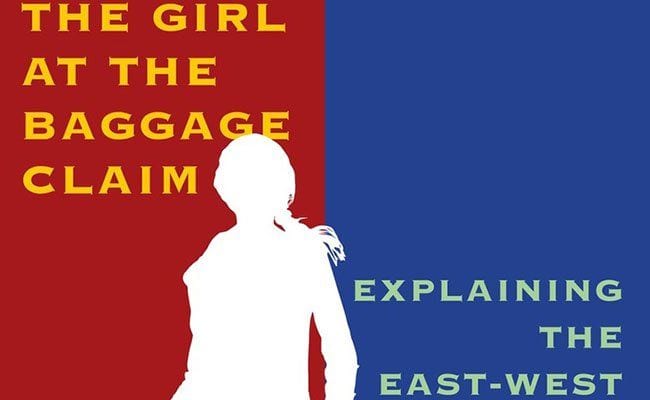
Gish Jen’s Girl at the Baggage Claim begins with an anecdote, relating the story of a Chinese high schooler who arrives in the US to attend a private academy under false pretenses: her sister, it turns out, posed as her during the Skype interview with the school. The newly arrived transfer student not only is not a fluent speaker of English, she is utterly unprepared for what awaits her. This scenario is a starting point for Jen’s work in teasing out the differences between “East” and “West”: what might be an appalling act of dishonesty in the independent-focused United States is understood as cooperative actions on behalf of others for the Chinese family striving for the young student’s best outcome.
As an American-born daughter of Chinese immigrants, Jen’s journey into the questions she addresses began as a personal one, as she struggled to understand herself and others. Yet the book is far from being a memoir, as she draws extensively on research by psychologists and sociologists, along with ethnographic studies of individuals in various cultural configurations. As her numerous examples indicate, there’s no single phenomenon that can explain the cultural difference between East and West. This is perhaps more encouraging than not, as Jen’s premise eliminates easy generalizations and stereotypes while also making clear that for many people, there’s far more overlap than separation between cultures. The differences, she argues, are rooted in cultural conceptions of the self, and the self becomes the focus of her writing.
Readers who tend to skip introductory material are cautioned to begin with Jen’s preface, where she lays out some of the fundamental ideas for the book. She explains her use of the terms “big pit self” and “flexi-self” that become shorthand for everything that encompasses the attitudes and personalities that dominate ideas of West and East. The big pit self is drawn from thinking of the independent-oriented self as an avocado, constantly focused on its big pit. Admittedly, there are negative connotations evoked by the visualization of “big pit self”, compared to the nimble, acrobatic image implied by “flexi-self”. Yet, early on, Jen assures that reader that we all have both a big pit self and a flexi-self, rendering the individual capable of transformation. Several of the examples she draws on show the effects on individuals, mostly students, who move from one culture to another, attesting to the role that context plays in shaping an individual’s self-perception and identity.
In China, the boundary around self is far more fluid than it is in the United States. Jen devotes careful attention to the idea of cooperative endeavor in China that is typically understood as counterfeit or forgery in the United States, where interdependence may be difficult for many to grasp. While the imposter Apple Store (or “Stoer” as Jen reports it was called in one location) in China is a breach of trust and copyright, the artists in the Dafen Oil Painting Village who churn out reproductions of Monet and Leonardo da Vinci paintings may be committing less offensive forgeries. Both instances reflect the relaxed boundaries of individuality that are part of an interdependent culture.
Yet Jen also uses Bob Dylan as a contrasting example of a musical and literary pioneer who took care to ensure that listeners understand that his songs draw strongly from the traditional folk music that is a foundation for his own. Tying originality to artistic excellence is taken for granted in independent cultures, even though many esteemed artists like Dylan see themselves more as carrying on a tradition that breaking new ground.
In her discussion of big pit selves, Jen draws on an acronym that should have earned broader popularity by now: WEIRD, or Western, Educated, Industrialized, Rich, and Developed. These five markers are prominent among residents in the United States, but far less so in any other part of the world. While the WEIRD still seek connection with others, Jen says, their motivation is not to act and interact for community benefit. Their goal is to be bigger, better big pit selves. Yet the focus on the self in the United States is not unfamiliar: from the self-absorbed “Me Generation” of Baby Boomers to the so-called “Me Me Me Generation” of Millennials, the fabled bold individualism of pioneers and frontiersmen evolved into something that frequently borders on narcissism. Being self-involved may be familiar and taken for granted by many in the United States, but, Jen asks, at what cost?
The first two parts of the book are devoted to the flexi-self and the pit self, with the third section considering ambidependence, the term Jen uses to describe a blending of independence and interdependence. Ambidependence could be the quality embraced and performed by those who aspire to be “global citizens”, and there’s an optimism drawn from the idea that being a global citizen does not privilege the big pit self or the flexi-self. Rather, it requires self-understanding and an awareness that the motivations of others may be fundamentally different from our own.
Jen says that writing Girl at the Baggage Claim was far more like writing a novel than she had anticipated. The qualities of carefully rendered fiction shine through in her book, turning a study of culture and psychology into an engaging narrative. Whether in commerce, diplomacy, or travel, readers can take away memorable insights into how identity and context shape worldviews. These same insights apply to the everyday lives of readers who live in increasingly diverse communities, where neighbors who seem weird at first can become more familiar.


![Call for Papers: All Things Reconsidered [MUSIC] May-August 2024](https://www.popmatters.com/wp-content/uploads/2024/04/all-things-reconsidered-call-music-may-2024-720x380.jpg)



